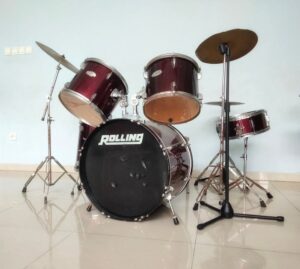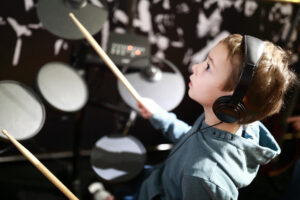 For parents readying themselves for their child’s first drum kit, the process can seem daunting. Brand new, complete drum kits can be a big expense, especially when your child is just starting out with drum lessons in Orlando. The good news is this: If you’re willing to put in a little effort into researching or piecing together a used kit, you can get great equipment for a fraction of the cost. As your child progresses in their drum lessons and skill, they’ll learn what they do and don’t like in a drum kit, so you can upgrade piece by piece according to their brand, sound, or technical preference.
For parents readying themselves for their child’s first drum kit, the process can seem daunting. Brand new, complete drum kits can be a big expense, especially when your child is just starting out with drum lessons in Orlando. The good news is this: If you’re willing to put in a little effort into researching or piecing together a used kit, you can get great equipment for a fraction of the cost. As your child progresses in their drum lessons and skill, they’ll learn what they do and don’t like in a drum kit, so you can upgrade piece by piece according to their brand, sound, or technical preference.
When you’re starting out with drum lessons in Orlando, think small at first. Putting together a small but quality drum kit is going to be better than purchasing a low-quality, brand new, large drum kit. For your child’s first drum kit, you’ll want to look for:
- Snare drum
- Bass drum
- 2-3 toms
- Hi-hat
- Ride or Crash cymbal
- A pedal
- Stand
- Seat
- Hardware
What to Expect When Shopping for Your Child’s First Drum Set
From the start, you’ll want to be realistic about your budget and your goals for this initial drum kit. For beginners, it’s generally advised to consider buying used, regardless of your budget. This is because whether it’s a whole kit being sold together or whether it’s something you’re piecing together, you’re likely to upgrade your equipment later on as your child gets better at the drums. Your budget will be the driving force behind what you end up purchasing.
Let’s start with a low budget of a few hundred dollars to spend on an entire used drum kit. In this price range, you might have to compromise on some pieces- whether it be in quality or brand or the amount of work it will take you to make a piece usable again. Depending on how much time you have to purchase your drum kit, and if you have more than a few hundred dollars in your budget, you’ll have more flexibility to find good deals on used drums or kits. If your budget allows, it’s best to start buying used drums and cymbals and save some of your budget for higher-end accessories.
When it comes to hunting for your drum kit so your child can start their lessons with drum teachers in Orlando, make sure you check all the usual places like eBay, Craigslist, Gumtree, Facebook Marketplace, and local musicians groups (on Facebook or through a store or community group). Don’t forget to check pawn shops and local music stores. It’s probably best to stay away from thrift shops like Goodwill or the Salvation Army as those are generally places people send their broken or low-quality instruments.
Your Child’s First Drum Kit: Pieces You Shouldn’t Compromise On
It can be really tedious to fully research and understand everything you need to know about how to set up a drum kit. We’ve done our best to compile a list of the non-negotiables and the pieces you can compromise on when it comes to purchasing used equipment for your child’s first kit. And if you’re on a tight budget, you may not be able to get pieces that check all the boxes, so make sure you’re putting money into the important stuff!
The first thing you should consider a non-negotiable is a round drum. It may sound silly, but especially with used rums, you run the risk of coming across an ill-shaped drum. Any drum that isn’t round isn’t worth buying at all. It would be completely useless as you would not be able to tune them, and therefore they won’t sound good. To make sure that your drum is round, measure the diameter of the drum all the way around. It should be the same all the way around and no more than 2/16 or approximately 3 mm out of round.
The next thing you should not compromise on is bearing edges. While not as totally worthless as a non-round drum, bad bearing edges do have a significant impact on the sound and tuning of your drum set. Bearing edges are the part of the drum that connects with the drum shell, creating a seal. This seal needs to be good all the way around the drum. Any bearing that looks warped, cracked, dented, or chipped probably has not been well taken care of, and you should avoid it unless you want to do the work of repairing it.
Pieces Where You Have Some Flexibility
Drums are made with thin pieces of wood that have been stuck together. If these separate, it can prevent the drum from correctly resonating. Ply separation is a bit of a spectrum, so if you’re looking at a drum with a lot of separation, it may be best to avoid it. However, a drum with only a slight or one separated ply might be worth your while depending on the price and your ability to fix it. You can do a quick check by running your finger around the edge to see if you notice anything that has become unstuck.
Another non-deal breaker when it comes to putting together your drum kit for drum lessons in Orlando is a non-round hoop. Hoops are inexpensive to replace, so if you find a great drum with a slightly off hoop, that’s OK.
While drum hardware is important as it supports everything you have in the drum kit, you should be able to find decent hardware on your used items. There’s a lot of hardware when it comes to drum kits, but if you’re willing to replace them as needed, this is definitely an area where you can save money. In the short term, as your child gets acquainted with their new drum set, this hardware will be less important than other pieces in the kit. As you’re scoping out used drums and accessories, make sure nothing wobbles and everything is sturdy and level.
Our goal is to help your child get started on a musical journey that will last a lifetime. Lessons in Your Home also offers virtual music lessons making it extremely convenient for those who prefer this option. Our online music lessons are taught by local music teachers who are well experienced, focus on each student’s individual needs, and plan their lessons accordingly.
